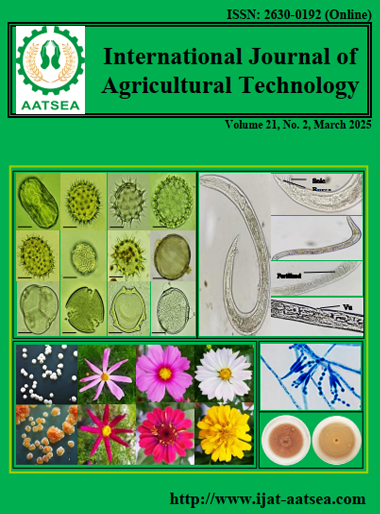Stingless bees collecting pollen in durian orchards, Khao Khitchakut District, Chanthaburi Province
Main Article Content
Abstract
Stingless bees are small social insects that collectsnectar and pollens from plants for food and play a crucial role in pollination. The results are identified into two species: Tetragonula pagdeni and Lisotrigona furva. T. pagdeni primarily collected the dominant pollen from nectar-rich flowering plants which were Asystasia gangetica (83%), Tridax procumbens (65%), and Wedelia trilobata (53%). Interestingly, T. pagdeni collected the occasional pollen from Durio zibethinus (L.) which was “Mon-Thong (1%) and Kradum Thong (1%). Unlike T. pagdeni, the smaller L. furva focused on various plants and weedy plants with smaller flowers, which, collecting pollen from A. gangetica (12-20%), T. procumbens (14-18%), Bougainvillea glabra (15%), Gomphrena globosa (8%), Eleutheranthera ruderalis (11%), and Eleusine indica (13%), and however, no pollen of D. zibethinus was observed. Overall, the study shows that both species adapt their foraging behavior in response to environmental changes, such as El Niño and La Niña, highlighting their resilience and adaptability to survive in varying climatic conditions.
Article Details

This work is licensed under a Creative Commons Attribution-NonCommercial-NoDerivatives 4.0 International License.
References
Bareke, T. A. A. (2019). Pollen analysis of honey from borana zone of Southern Ethiopia. Journal of Apicultural Science, 63:233-242.
Barth, O. M. (1989). O pólen no melbrasileiro. Rio de Janeiro: Luxor. 150p.
Boontop, Y., Malaipan, S., Chareansom, K. and Wiwatwittaya, D. (2008). Diversity of Stinglee bees (Apidae: Meliponini) in Thong PhaPhum District, Kanchanaburi province, Thailand. Kasetsart Journal (Natural Science), 42:444-456.
Canche, I. M., Ordonez, Y. M., Mora, J. V., Cadenas, R. G., Nunez, B. T., Rodriguez, L. A., Piana, L. and Vandame, R. (2020). Sensory and physicochemical analysis of honeys of nine stingless bee species of Mexico and Guatemala. Journal of Food Science and Technology (JFST), 59:4772-4781.
Cardona, Y., Torres, A. and Hoffmann, W. (2019). Colombian stingless bee honeys characterized bymultivariate analysis of physicochemical properties. Apidologie, 50:881-892.
Chelog, I. (2021). Foraging plant and palynological analysis of stingless bee potpollen in Pattani, Thailand. Journal of Physics: Conference Series. 2nd International Annual Meeting on STEM education (I AM STEM), 1-6.
Cuttong, B., Chanbang, Y., Sringarm, K. and Burgett, M. (2016). Effects of long-term storage on stingless bee (Hymenoptera: Apidae: Meliponini) honey. Journal of Apicultural Research, 54:1-11.
Engel, M. S., Rasmussen, C., Ayala, R. A. and Oliverira, F. F. (2023). Stingless bee classification and biology (Hymenoptera, Apidae): a review, with an updated key to genera and subgenera. ZooKeys, 1172:239-312.
Jongjitvimol, T. and Wattanachaiyingcharoen, W. (2007). Distribution, nesting sites and nest structures of the Stingless bee species, Trigona collina Smith, 1857 (Apidae, Meliponinae) in Thailand. The Natural History Journal of Chulalongkorn University, 7:25-34.
Karabagias, I. K., Maia, M., Karabournioti, S., Gatzias, I., Harabagias, V. K. and Badeka, A. V. (2020). Palynological, physicochemical, biochemical and aroma fingerprints of two rare honey types. European Food Research and Technology, 246:1725-1739.
Michener, C. D. (2007). Lisotrigona in Thailand, and the Male of the Genus (Hymenoptera: Apidae: Meliponini). Journal of the Kansas Entomological Society, 80:130-135.
Momse, K., Atada, A. H., Amaoka, R. Y. and Noue, T. I. (1988). In press. Polli-nation biology of the genus Artocarpus, Moraceae. Tropics., Nngamitsu, T., and Inoue, T. 1998. The reproductive ecologyof an emergent dipterocarp in a lowland rain forest in Sarawak. Plant Species Biology, 11:189-198.
Neto, J. S. L., Lopes, J. A. D., Neto, J. M. N., Lima, S. G. L., Luz, C. F. P. and Cito, M. G. L. (2017). Volatile compounds and palynological analysis from pollen pots of stingless bees from the mid-north region of Brazil. Brazilian Journal of Pharmaceutical Sciences, 53:1-9.
Ng, W. J., Hew, P. S., Loo, C. B. and Ee, K. Y. (2024). Investigation of the sensory attributes, physicochemical characteristics, and functional properties of Malaysian stingless bee honeys: a chemometric approach for comprehensive honey assessment. Journal of Food Measurement and Characterization, 18:6209-6224.
Song, X. Y., Yao, Y. F. and Yang, W. D. (2012). Pollen analysis of natural honeys from the central region of shanxi, north China. PLoS ONE, 7:1-11.
Syafrizal, Kusuma I. W., Saud O. R., Wiandany R., Yahya M. F. and Harmonis. (2020). Conservation of kelulut (stingless bee) in East and North Kalimantan, Indonesia. IOP Conference Series: Earth and Environmental Science, 591:1-6.
Thakodee, T., Deowanish, S. and Duangmal, K. (2018). Melissopalynological analysis of stingless bee (Tetragonulapagdeni) honey inEastern Thailand. Journal of Asia-Pacific Entomology, 21:620-630.
Toledo, C. E., Ovando, A. V., Santos, R. T., Garcia, A. L., Flores, V. A. and Conesa, J. G. (2018). Stingless bee honeys from Soconusco, Chiapas: a complementary approach. RevistaBiologia Tropical, 66:1536-1546.


